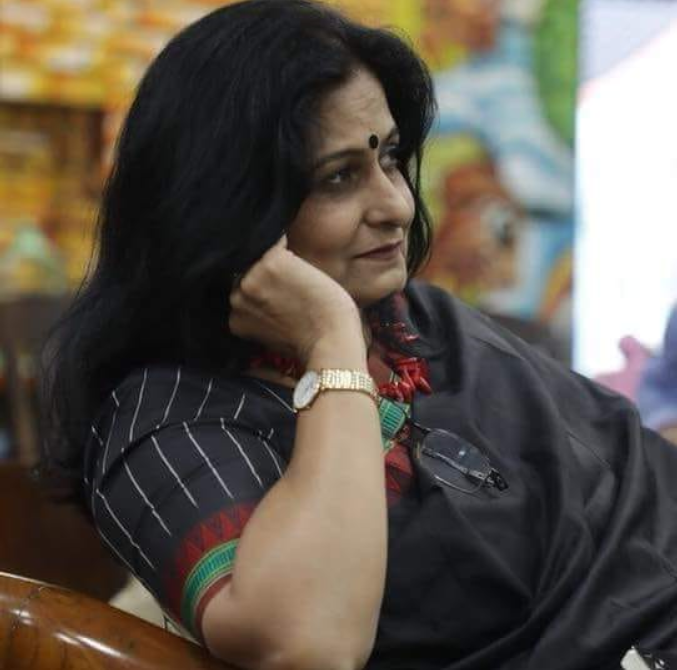Unprecedented reach with unlimited participation opportunities

Dr. Leena Jha
Business Communication Consultant
Aug, 2018 (I) By Dr. Veenita Shah
Dr. Leena Jha is a freelance Business Communication consultant, and a visiting Professor at IIT Bombay. She has served as a co-instructor in IITBombayX MOOCs, namely Technical Communication for Scientists and Engineers; and Soft Skills and Workplace Communication. Devoted to encouraging enthusiastic learning amongst students, with confidence building at its core, Dr. Jha has been working with SJMSOM, IIT Bombay, since 2008. Dr. Jha got involved in MOOCs due to her passion for teaching and reaching out to people. “MOOCs has an unprecedented reach with unlimited participation opportunities, which makes us conscious about our responsibilities as instructors. My experience with MOOCs was a dream come true since I always wanted to reach out to people, especially in the remote areas. In this journey, I have also learnt the art of being precise and concise since we intend to deliver meaningful content in short modules.”
The emergence of MOOCs promises the potential to change the way we receive education. It also fills the void for learners who lack the time or money to physically attend courses featuring high-quality content. Remarking on the difference between classroom learning and MOOCs, Dr. Jha states that classroom teaching has its own flexibilities, which cannot be substituted. She told, “In my course of Communication, I provide liberty to students to debate and discuss on a given topic, allowing them a lot of mileage. The takeaway in such a classroom coaching is the gain in confidence since there is somebody guiding you throughout. Since my courses are recorded, the students go back and also watch the videos to learn about their body language, which has become an important aspect these days.”
“I think that online learning will be the future of tomorrow, and MOOCs is going to be a major force in the coming years.”
The pacing of a course, which refers to how a course instructor runs the course, and how learners can interact with the course material may vary from instructor-paced to self-paced in a blended or non-blended model. Dr. Jha states her preference for instructor-paced course in a blended model. “I have been in the field of teaching for quite some time, and my interaction with students in classroom learning as well as MOOCs suggests that they are likely to finish their tasks at the eleventh hour, which certainly impacts learning. In an instructor-paced course, students are motivated to finish the course within a timeline. In the blended model, instructor-paced course would be ideal for students since they would be synchronised with each other to raise queries during the face-to-face interactions. However, in a self-paced mode, the intended learning may not occur as students are likely to procrastinate the tasks till the deadline,” she shared.
Face-to-face interactions in MOOCs connects participants with their peers, and permits them to raise queries and interact on a wider platform. This benefits the learners by providing them with a sense of community as against isolated pursuit in this journey of online learning. To add to this, Dr. Jha conveys that face-to-face interactions with the students in MOOCs are rewarding experiences. “The interactions not only help the learners clear their doubts, but also guide us in preparing the course. We realize, at times, that queries and questions put forward by participants have not been considered as concerns by us at all. This is how we come to learn about their anxieties and apprehensions, which help us in framing our course structure in a better format. We cannot follow the “one size fits all” concept in MOOCs. To accommodate the diversity in MOOCs, we need to simplify the learning process, without compromising on the content quality, using concepts and tools, which can be comprehended by all,” she told.
“To accommodate the diversity in MOOCs, we need to simplify the learning process, without compromising on the content quality, using concepts and tools, which can be comprehended by all.“
For seamless transmission of knowledge through MOOCs, robust network connections, supporting advanced technical capabilities, across participating schools and institution is a necessity. Dr. Jha points out one of the current challenges in MOOCs in India. She mentioned, “Since MOOCs is a technology-enabled program, the technology has to be flawless, at both ends – the instructor as well as the learner. Effective web connectivity is critical for face-to-face interactions in blended MOOCs, especially during the synchronous interactions of multiple remote centres with the principal institution.”
Regardless of several challenges, online learning has made great strides in recent years, with more and more institutions introducing their online education platforms. Dr. Jha believes that education is going to be online in future since it provides a wider knowledge-base, and has a wider reach. “Online learning fuels our thinking while exploring related concepts, and enhances our knowledge. I think that online learning will be the future of tomorrow, and MOOCs is going to be a major force in the coming years. Though lack of immediate feedback from the mentor is a disadvantage of MOOCs, learning through videos increases the sharpness of mind, the alacrity of learner and reception of content. Hence, the quality of videos should be well-designed, including self-explanatory animations, as the images and visuals stick around with the learners for long,” she told.
Encouraging participants towards education is a bigger cause. MOOCs aims at benefiting the diversity at large. Motivating the learners in MOOCs, Dr. Jha stated, “Learners, even at the remotest places, have access to these courses, and their instructors at the discussion forums. It augments their confidence, enlarges their knowledge base and helps them reach out to other learners.” Dr. Jha also feels that MOOCs content can be moulded in a way to attract learners. “Matching the content of MOOCs with the interest of learners should encourage more participants. Accreditation from IITBombayX or recognition from industry would also benefit learners’ cause.”
Dr. Jha concluded by appreciating the team at IIT Bombay, “It was a wonderful experience to work with the IITBombayX team. They have been most supportive, and we couldn’t have done these courses without them. We have gotten valuable feedback from the content team, video recording team and the workshop team in making our courses more effective.”




